List of Christian women of the patristic age
This is a list of Christian women in the patristic age who had roles in the development of the early Christian churches and communities. Many of these women were examples of piety for both men and women in the Church. Some of these are also martyrs and saints. The patristic era is considered to have started at the end of the 1st century and to have ended towards the close of the 7th century.[1]
| Name and or also known as | Year died | Image | Location | Description |
|---|---|---|---|---|
| Blandina | 177[2] | _bpt6k6350834v-1.jpg.webp) |
Lyon | Blandina was a slave who was put in prison for being a Christian along with her master. She endured beatings, burning, attacks by a steer and was finally killed with a dagger.[2] |
| Macrina the Younger | 379[3] | 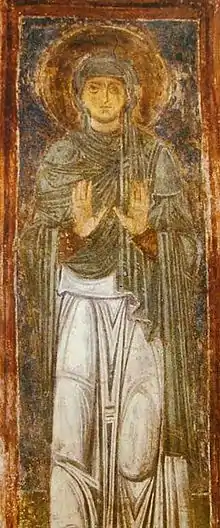 |
Cappadocia | Macrina was intelligent and educated. After her fiance died suddenly when she was twelve, she vowed not to marry. She took care of her family and supported them after her father died. She was influential in the education of the Bishop of Sebaste and St. Gregory, her brothers. She also established a religious community and became its head.[3][4] |
| Perpetua | 203[5] | 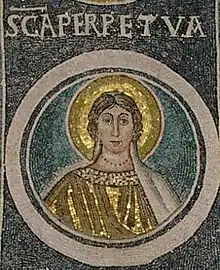 |
Carthage | Saint Perpetua was arrested with Saint Felicitas, Saturnius, Revocatus, and Secundulus. Perpetua and her companions are examples of those who would not deny being a Christian despite being placed in gladitorial/animal shows.[6] While in prison, she gave birth to a son and put him into the care of others.[5] |
| Felicitas | 203[5] | .jpg.webp) |
Carthage | Saint Felicitas was arrested along with Saint Perpetua and others and placed in gladiatorial/animal shows. She did not deny being a Christian.[6] She was pregnant when she was arrested. In jail, she gave birth at eight months to a girl who was given to 'sisters' to raise.[7] |
| Cecilia | 177[8] | .JPG.webp) |
Rome | Cecilia is a relatively well known Roman martyr and there are variations in the records about her.[9]She was a noble lady of Rome who, with her husband Valerian, his brother Tiburtius, and a Roman soldier named Maximus were killed for being Christians.[10] One account of Cecilia's death says that after being struck three times on the neck with a sword, she survived for three days.[9] |
| Lucy | 304[11] | 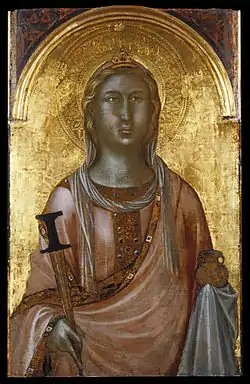 |
Syracuse, Sicily | Lucy worked with the poor and those confined to their homes by bringing them food. She is also thought to have done the same for those Christians hiding in the catacombs.[12][6] |
| Catherine of Alexandria | early 4th century[13][14] | 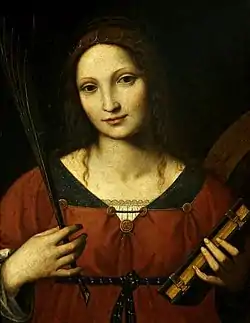 |
Alexandria | Catherine of Alexandria was a saint who was martyred in the early 4th century by Maxentius. She was both a princess and a noted scholar, who became a Christian around the age of 14, converted hundreds of people to Christianity, and was martyred around the age of 18. More than 1,100 years following her martyrdom, Saint Joan of Arc identified Catherine as one of the saints who appeared to her and counselled her.[15] |
| Agnes | 304[16] |  |
Rome | Twelve year old Agnes was from a noble family and engaged to the son of a city official. She informed him that her fiancé was Jesus Christ. She was subsequently stripped and stabbed through the throat 'like a lamb'. "[H]er long curls enveloped her like a dense cloak, and an angel brought her a light robe that shone through the whole house."[6] |
| Helena | 330 | 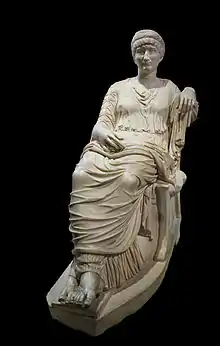 |
Constantinople | Helena was the Empress of the Roman Empire, and mother of Emperor Constantine the Great. She was born a commoner, possibly in Drepana, Bithynia in Asia Minor. She became the consort of the future Roman Emperor Constantius Chlorus (reigned 293–306). Helena was an important figure in the history of Christianity.[6] |
| Monica | 387[17] |  |
Alexandria | Monica had great influence over the development of her son Saint Augustine's faith. It was her prayerful life that influenced the conversion of Augustine. "[She] exemplifies qualities of patience, persistence, and piety that believers of all stripes can appreciate."[18] Augustine writes about her extensively in his book Confessions. [19][17] Augustine and his friends would gather for discussions on philosophy and he would ask Monica to join in the discussions.[20] She also was known for her charitable works.[21] |
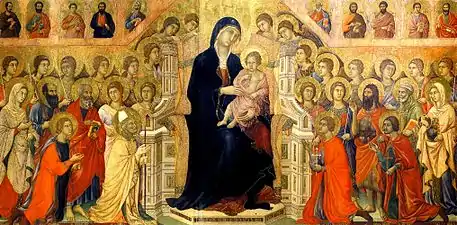
Christian women in the patristic age appear in later works of art.
References
- "Glossary Definition: Patristic Era". www.pbs.org. Retrieved 2019-05-16.
- "CATHOLIC ENCYCLOPEDIA: St. Blandina". www.newadvent.org. Retrieved 2019-03-25.
- "CATHOLIC ENCYCLOPEDIA: St. Macrina the Younger". www.newadvent.org. Retrieved 2019-04-03.
- "Macrina of Cappadocia, sister of holy hierarchs Basil the Great and Gregory of Nyssa, venerable | RUSSIAN ORTHODOX CATHEDRAL OF ST.JOHN THE BAPTIST". stjohndc.org. Retrieved 2019-04-03.
- "CATHOLIC ENCYCLOPEDIA: Sts. Felicitas and Perpetua". www.newadvent.org. Retrieved 2019-06-25.
- Plassman, Thomas; Vann, Joseph. Lives of Saints with Excerpts From Their Writings. John J. Crawley and Co., Inc. pp. 11, 28, 29, 40, and 42.
- "The Martyrdom Of Saints Perpetua And Felicitas | From Jesus To Christ | FRONTLINE | PBS". www.pbs.org. Retrieved 2019-06-26.
- "Cecilia | Saints Resource". saintsresource.com. Retrieved 2019-06-25.
- Foley O.F.M., Leonard. "Saint of the Day", (revised by Pat McCloskey O.F.M.), Franciscan Media ISBN 978-0-86716-887-7
- Fuller, Osgood Eaton: Brave Men and Women. BiblioBazaar, LLC, 2008, page 272. ISBN 0-554-34122-0
- Media, Franciscan (2015-12-13). "Saint Lucy". Franciscan Media. Retrieved 2019-06-25.
- "About Saint Lucy | St. Lucy Catholic Parish". Retrieved 2019-03-28.
- "St. Catherine of Alexandria | Egyptian martyr". Encyclopedia Britannica. Retrieved 2019-06-25.
- "St. Catherine of Alexandria". www.nndb.com. Retrieved 2019-06-25.
- Williard Trask, Joan of Arc: In Her Own Words (Turtle Point Press, 1996), 99
- "Who Was Saint Agnes? | The Church of Saint Agnes". www.saintagnes.com. Retrieved 2019-06-26.
- Coffman, Elesha. "Faith of Our Mothers". Christian History | Learn the History of Christianity & the Church. Retrieved 2019-04-16.
- History (2018-08-27). "Augustine's Mother Monica Illustrates The Power Of Mothers And Prayer". The Federalist. Retrieved 2019-04-15.
- "St. Monica Catholic Church". www.stmonicaindy.org. Retrieved 2019-04-15.
- "St. Monica". Midwest Augustinians. Retrieved 2019-06-30.
- "St. Monica". www.ewtn.com. Retrieved 2019-06-30.
See also
This article is issued from Wikipedia. The text is licensed under Creative Commons - Attribution - Sharealike. Additional terms may apply for the media files.
